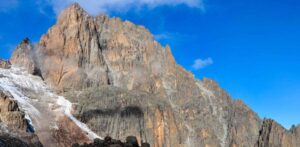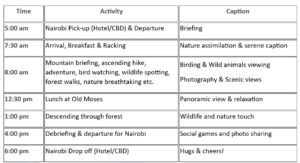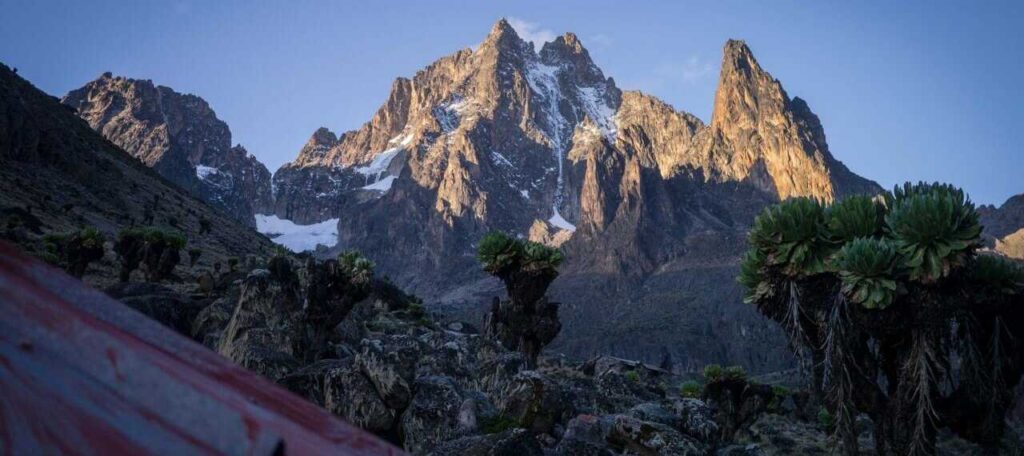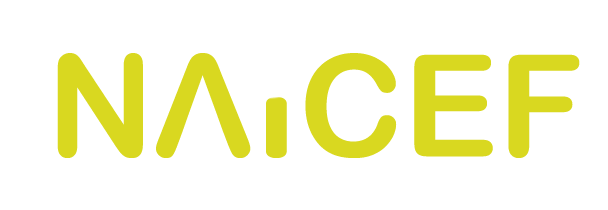Climbing Mount Kenya is an ultimate goal destination for the most adventurous people. It is a thrill to behold. Naicef being the best professional tourism company in Kenya will guide you with all the best guides to climb Mount Kenya and show you all the best Mount Kenya routes.
The article further links you with good climbing Mt Kenya packages, a guide to the best time to hike Mount Kenya, Mt. Kenya hiking cost, and tips from the planning stage, travel, and accommodation to climbing Mount Kenya.
Climbing Mount Kenya – A Thill to Behold
Mount Kenya routes offer the best opportunity to scale limits, trigger your energy, and open your eyes to a world of panoramic beauty full of natural freshness. If you are passionate about hiking, Mount Kenya is a must destination.

Picture: NMK
Why is Mount Kenya the best hiking destination in Africa?
Mount Kenya is the best hiking trail in Africa since it gives you more than an adventure with Alpine, exciting trekking routes for real mountain climbers.
While hiking Mount Kenya, you will be able to not only hike Mount Kenya using the three adventurous route options but also have the best opportunity to see the rare wild species like the mountain bongo, hundreds of bird species, the big five of Kenya that include the buffalos, elephants, and leopards.
Other factors that make Mount Kenya the best hiking route in Africa are that you will enjoy a UNESCO World Heritage natural forest, beautiful mountain lakes, panoramic views, and many more.
Moreover, Naicef adventure professionals help you get the best package for hiking Mount Kenya based on your budget, condition, number, or cultural and experiential package interest.
Where is Mount Kenya? Mt Kenya Location and Overview
Since most people keep asking where Mount Kenya is located? Mount Kenya is in the Central of Kenya, a few kilometers South of the equator.
Kenya was named after this mountain since it is the highest point in Kenya. Moreover, Mount Kenya is the second highest mountain in Africa after Mount Kilimanjaro at the border of Kenya and Tanzania.
It is approximately 193 kilometers from Nairobi. For anyone coming to Kenya, Nairobi is the entry point by air through the largest airport in Kenya and East Africa.
For anyone coming from the coast, Mt Kenya is 480 kilometers from Mombasa. Mombasa is the largest seaport and hosts the second-largest airport in Kenya. Moreover, driving to Mount Kenya from Nairobi or Mombasa is quite good due to the good roads and the cultural and experiential views along the road.
How High is Mount Kenya?
Mount Kenya is 5199 meters high. Mount Kenya is the highest point in Kenya and the second highest in Africa after Kilimanjaro.
So how high is Mount Kilimanjaro? Mount Kilimanjaro is 5895 meters high. However, for anyone looking for the best adventure experience in Africa, climbing Mount Kenya is more experiential due to the three standing peaks and the adventurous routes up the mountain.
The three Mount Kenya routes towards points Batian, Nelion, and Lenana are challenging hence requiring good hiking gear and fitness. Mount Kenya gives you a more attractive appeal due to the jagged rocks, and rugged slow, sharp cliffs.
Below is an outline of Mount Kenya highest peaks.
What are the names of Mount Kenya peaks?
The three Mount Kenya peaks are Batian, Nelion, and Lenana. But what is Mount Kenya’s highest peak? Below is a guide to all the Mount Kenya peaks.
The Highest Mount Kenya Peak
The highest Mount Kenya peak is called Batian which is 5199 meters high. Batian being Mount Kenya highest peak offers a technical ascent making it the hardest peak to hike.
This requires your best mountaineering skills to reach the top. The first recorded person to reach Batian was Mackinder Halford in 1899. He has a camp to his name up the mountain.
However, more people continue to reach the top over the years. It takes 5 to 8 days to hike up to Batian.
 Picture: MCK
Picture: MCK
The Second Highest Mount Kenya Peak
The second highest Mount Kenya peak is called Nelion which is 5188 meters high. Nelion is just 20 meters lower than Batian but on sharp ascent.
Point Nelion being the second-highest Mount Kenya peak is hard to hike since both Batian and Nelion require specialized mountaineering skills and adventure gears. Anyone planning to climb Mount Kenya to Nelion is fit enough to reach Batian, a higher milestone.
The Third Highest Mount Kenya Peak
The third highest Mount Kenya peak is Lenana which is 4985 meters high. This means Lenana is less than 250 meters and 200 meters lower than Batian and Nelion respectively on a sharp ascent.
Most people climbing Mount Kenya reach Lenana the third highest Mount Kenya peak. This is because Point Lenana is safer and offers an equally stunning view and great trekking experience.
Below is a table of the three highest Mount Kenya peaks.
| No. | Mount Kenya Highest Peaks Order | Height (Meters) | Terrain |
| 1. | Point Batian | 5,199 | Highly Challenging |
| 2. | Point Nelion | 5,188 | Difficult Challenge |
| 3. | Point Lenana | 4,985 | Fairly Challenging |
Source: (Naicef Research Team, 2024)
What are the three Mount Kenya routes?
The three Mount Kenya routes are Chogoria, Naro Moru, and Sirimon. To have the best experience in climbing Mount Kenya, different factors determine the best route to use for your adventure.
Among the three Mount Kenya routes, what is the best route to hike mount kenya? Below is a comprehensive description of the three Mount Kenya Routes and their differences.
Mount Kenya Chogoria Route
Chogoria route Mount Kenya is the best experiential route for anyone climbing Mount Kenya. The Chogoria route Mount Kenya is highly scenic and doesn’t have huts.
Therefore hikers highly blend with nature while camping up the mountain. You can access Mount Kenya Chogoria route from Embu towards Chogoria town. While Naicef is packaging the Chogoria route, we ensure you get the best natural camping experience in the safest way possible for your adventure.
Through the Chogoria route Mount Kenya, you will have the best scenes like Urumandi Falls along the tussock grass and moorlands.
Moreover, at 3390 meters high, you will enjoy the best and most beautiful mountain lake, lake Ellis. A highly refreshing experience that gives you a panoramic view of Mount Kenya spikes. If you love photography, ensure you capture the best of all your mountaineering experience here.
Further, at Lake Ellis, there lies a fantastic view of the Gorge Valleys. Through the Chogoria route up Lake Ellis, you will find Lake Michaelson, another great scenic beauty to behold and capture for takeaway memories.
 Picture: KWS
Picture: KWS
Right after that, you will find a rocky but beautiful Hall Tarn camp and Mintos, a beautiful camping ground at 4230 meters. Camp Minto through the Chogoria route offers you the last night before you reach Point Lenana, the third-highest Mount Kenya Peak.
Therefore, you rise at 2:00 am and hike with a head touch to help you scale the last few meters to Point Lenana and enjoy a sunrise at the top.
Chogoria Route Mount Kenya gives you the very best of experience, views, and photographic panorama for a lifetime. That is why it makes climbing Mount Kenya a picturesque trekking mountain in Africa. Would you prefer to climb Mount Kenya via the Chogoria route? Contact Naicef here.
Mount Kenya Naro Moru Route
Naro Moru route Mount Kenya is the easiest route for anyone climbing Mount Kenya. Despite Naro Moru being the quickest route, it is not as scenic as the Chogoria route although it is good for fair hikers who might not want to get rough terrains.
Naro Moru is closer to Nyeri town and along the Nyeri Nanyuki highway. From Mount Kenya National Park via the Naro Moru route, there are 17 kilometers to the Percivals bridge at 2400 meters.
This is an ideal distance to help you acclimatize in preparation for the main hike. Up the Naro Moru route via the Percival bridge you get to Metrological station that offers some good relaxing camp at 3050 meters.
At Met station, the natural views offer a therapeutic experience for that longed wild experience. Progressively from Met Station, an awaiting forest trail with some moorland takes you through the wet terrain for a thrilling forest hike in the vertical bog.
Climbing Mount Kenya through this point leads you to Taleki Valley descending to Mackinders camp which has well-kept huts to accommodate you for the night. Mackinders camp is 4200 meters a distance that will take you approximately 5 to 6 hours from Met Station through the forest and moorland.
Quite a hilarious hike. From Mackinders camp, you will proceed to the third Mount Kenya highest peak point Lenana which is 4985 meters through the circular path and the Australian Hut.
However, hiking from Mackinders camp to Point Lenana takes approximately 5 hours due to the 785-meter elevation on loose gravel. Therefore, the hiking tactic from Mackinders camp to Lenana is to wake up at 3 am to ensure sunrise finds you at the top of Point Lenana.
Despite the elevation, not much expertise is needed here to reach Point Lenana. From point Lenana climbing Mount Kenya down you can use Australian Hut as your camp along Taleki Valley.
The Lewis Glacier offers a great view as you descend to the Australian Hut although the glacier has greatly reduced and degraded due to global warming over the last two decades.
Would you love to climb Mount Kenya via the Naro Moru route? Well, contact Naicef here for a sustainable safe experience.
Mount Kenya Sirimon Route
Mount Kenya Sirimon route is also an easy hiking route for anyone climbing Mount Kenya to Batian, Mount Kenya’s highest peak. Sirimon route is simple and less strenuous than the three Mount Kenya routes.
You can access the Sirimon route through Nanyuki town, a cool tourist town at the foot of Mount Kenya. The Mount Kenya Sirimon route has a clear tarmac path from Sirimon Gate through the beautiful refreshing forest to Old Moses Camp.
Judmaier camp is also a good alternative for camp lovers. Despite the good tarmac through the forest, it is good you hike from the gate to acclimatize in readiness for the main hike.
After Old Moses or Judmaier Camps through the Mount Kenya Sirimon route, you normally climb to Shipton camp through the communication station.
Before reaching Shipton camp, you will pass through the Mackinder valleys and moorlands that give you a fantastic panoramic view like we did through the Chogoria route up Mount Kenya.
Interestingly, there is another trail from old Moses via the Communication station that would lead you to Liki North Hut which sits at 3990 meters. Despite Liki North not being an active camping hut like Shipton, you can camp for a stop before proceeding to enjoy the least known Sendeo or Terere Mount Kenya peaks.
From Shipton camp, it is easy to hike the challenging Batian the highest Mount Kenya peak. However, most people hike through the narrow chasm of loose gravel to point Lenana the third-highest Mount Kenya peak.
Mount Kenya Sirimon route gives the best 5 days climbing Mt Kenya packages. Would you love the best package to climb Mount Kenya via the Sirimon route?
Hit Naicef for the best Mount Kenya climbing tours.
Below is a table of the three Mount Kenya routes describing their uniqueness and terrain
| No. | Mount Kenya Routes | Toughness | Sceneries |
| 1. | Chogoria Route | Challenging | Highly scenic route Urumandi falls Grass and moorland Lake Ellis & Panoramic Photography Nature Gorge Valleys Lake Michaelson Hall Tarn camp and Mintos |
| 2. | Naro Moru Route | Mid Challenging | Fair terrain route Percivals bridge Met station Forest trail, vertical bog & Moorland Taleki valley Mackinders camp Australian Hut. Lewis Glacier |
| 3. | Sirimon Route | Least Challenging | Easy hiking route Old Moses Camp & Judmaier Camp Shipton camp Mackinder valleys panoramic view up the forest Communication station Terere Mount Kenya peaks Easy for Batian access |
Source: (Naicef Research Team, 2024)
Unknown Mount Kenya Routes
Did you know there are the least known routes to climb Mount Kenya?
These unknown routes to climb Mount Kenya include Kamweti, Timau, Meru, and Burguret.
However, these routes are not safe to climb Mount Kenya in their current condition and for the tourism sustainability of Mount Kenya as a world heritage site under UNESCO and managed by the Kenya Wildlife Service.
Therefore, anyone climbing Mount Kenya should use the three main Mount Kenya routes of Chogoria, Naro Moru, and Sirimon.
Naicef as a sustainable tourism organization, always encourages you to promote environmental, social, and economic sustainability by using the right routes.

Picture: MCK
Guide to climbing Mount Kenya
Naicef gives you the best guide to climb Mount Kenya by helping you understand how to prepare to climb the challenging Mount Kenya routes and trails.
Climbing Mount Kenya requires basic to technical preparation. Therefore, if you want to learn how to prepare to climb Mount Kenya, the first thing you need to know is which point you want to reach in Mount Kenya.
People who want to do a 1-day hike of Mount Kenya do not necessarily need the same preparation as those planning for an 8-day Mount Kenya hike.
Similarly, those planning to hike up to Batian the highest Mount Kenya peak need to understand more about how to prepare to climb Mount Kenya.
The skill is what you get from Naicef professional mountain guide but basic preparation is what you need to do.
Why does anyone need to learn how to prepare to climb Mount Kenya? The reason you need to prepare to climb Mount Kenya or hike any mountain is due to the following reasons.
Why Preparing to Hike Mount Kenya is Important
- Enjoy the hike – better prepared people enjoy the hike and the mountain more.
- Avoid body reactions such as organ breakdown – muscles won’t surprise your self-convicted imagination.
- Psychological preparation – mental acclimatization is equal to body preparation
- Endurance – better preparation helps you endure tough and challenging terrains
- Health reward – preparing to hike gives you a long-life reward of limitless benefits.
So how do you prepare to climb Mount Kenya? Below is a guide table of how to prepare to climb Mount Kenya across different Mount Kenya climbing tours and packages.
| No of Days | Route & Preparation | Preparation Duration | |
| 1 Day Hike | Chogoria | Mid-muscle fitness to walk a hill | 1 Week |
| Naro Moru | Fair muscle fitness to walk a hill | ||
| Sirimon | Basic muscle fitness to walk a hill | ||
| 3 Days Hike | Chogoria | Mid Fitness to Scale | 2 Weeks |
| Naro Moru | Mid Fitness to hike | ||
| Sirimon | Mid Muscle fitness | ||
| 5 Days Hike | Chogoria | Mid High Muscle Fitness | 1 Month |
| Naro Moru | Mid High Fitness | ||
| Sirimon | Mid High Muscle Fitness | ||
| 8 Days Hike | Chogoria | Intense deep fitness | 1 Month Plus |
| Naro Moru | High-level preparation | ||
| Sirimon | High-level fitness | ||
Source: (Naicef Research Team, 2024)
Therefore, when preparing to climb Mount Kenya, you should prepare according to your fitness, the duration you plan to hike, and the route you need to use while hiking, particularly Mount Kenya.
Naicef can help you understand your situation and offer personal recommendation for the best preparation. The following are ways to prepare how to climb Mount Kenya.
How to prepare to climb Mount Kenya
- Physical fitness – one best way to prepare to climb Mount Kenya is to be physically fit. Nevertheless, ensure you are fit for the mountain and after the mountain.
The best exercises to physically prepare to climb Mount Kenya is aerobic fitness like jogging, jumps, fitness dances, and cycling.
You can do this 3 or so times a week. Any other physical exercise like football, gym, swimming and such are also good to prepare you for the mountain. - Nutrition & Hydration – while preparing to hike Mount Kenya, always take a good amount of water since you should be taking more water while climbing Mount Kenya.
A minimum of 3 liters every day is good enough. Moreover, you should have a good diet that comes through good nutrition.
A good diet for the mountain includes good portions of protein, vegetables, carbohydrates, and fruits.
This builds your stamina for the mountain. Any other supplements that can help you build good stamina are good, ensure you personalize this for your own good. - Route Choice – while preparing to climb Mount Kenya, Naicef will guide you on the best route professionally.
This is customized since different people hike for different purposes and duration. We recommend you reach out us to help you fit the best route for your purpose and duration. - Get the best Mt Kenya climbing packages – Naicef gives you the best customized mt kenya climbing packages. We have the best 1-day hike, 3 days, 5 days, and 7 days Mount Kenya climbing packages.
Remember as we guide you professionally, we ensure we meet your hiking goal before, during, and after the hike.
Therefore, as you search for the best Mt Kenya climbing packages, they should be packages that are customized to your preference. - Get a professional Best Guide to climb Mount Kenya – the best guides to climb Mount Kenya are local and Kenyans who are accredited as mountain guides by the Tourism Regulatory Authority.
Naicef ensures all its guides are accredited and therefore all our best guides to climb Mount Kenya must be trained in tourism and guiding management.
Remember a good guide understands customer service, sustainability, security, all Mount Kenya routes, and first aid skills among other mountaineering experiences. Get a professional best guide to climb Mount Kenya here. - Get the best gear to climb Mount Kenya – having the best gear to climb Mount Kenya helps you enjoy and scale the mountain with ease.
The secret to getting the right and the best gear to climb Mount Kenya is finding a good mountaineering shop or sports shop that stocks mountaineering products.
Below are the best gear to climb Mount Kenya.
Gear to use to climb Mount Kenya
If you are preparing how to climb Mount Kenya well, ensure you have the following for the maximum benefit of the experience;
- Thermal Base Layer: thermal wear helps you keep warm, keeps you insulated, and wicking away from the sweat.
Mountaineering thermal wear helps you remain comfortable through the night. Moreover, it helps you reach the summit without fearing the cold mountain weather.
Ensure you get the best thermal of your size, that should not be tight or too loose. - Faster Drying Pants: these are pants preferred for the mount to ensure that in case there is rain, the pants can dry faster.
Moreover, in warm areas, the pants can dry off the sweat faster when you are not in thermal pants. - Fleece Jacket: this jacket is important to help you keep warm when the weather adjusts. Climbing Mount Kenya can get cold and after a few meters of climbing it gets cold.
While hiking Mount Kenya, you can alternate the fleece jacket with a hoodie. - Quick drying T-shirts: quick drying is a must-have gear to climb Mount Kenya since they help you remain warm and dry faster than any other materials.
This mountain hiking t-shirt helps you remain comfortable since the material that makes them is polyester which is better than cotton.
Cotton retains the sweat hence giving you discomfort. - Waterproof jacket: waterproof jackets help you as a Mount Kenya hiking gear by keeping you warm from the wind, retaining the body warmth, and drying faster while rained.
Ultimately, waterproof jackets protect you from soaking in rain and keep your inner wear safe from water.Other gears to use to climb Mount Kenya include:
- Puffer jacket
- Hiking buff
- Woolen hiking socks
- Waterproof hiking boots
- Hiking bag
- Headlight touch
- Hiking pole
- Sleeping bag
- Personal effects such as mini towels, sunscreen, painkillers, toiletries, snacks, etc.
Mount Kenya Map
Below is a Mount Kenya map that shows all the routes and major features to help you.
Climbing Mt Kenya Packages
There is an average of 4 types of climbing Mt Kenya package variations.
These are the best climbing Mt Kenya packages that help you select the best of your choice and preference.
Naicef helps you identify the best Mount Kenya climbing tours that fit your desire by understanding your hiking goal, duration, and outcome.
Therefore contact us here for a quick Mount Kenya climbing tour. Below are samples we can customize for you.
1 Day – Climbing Mt Kenya Hike Packages & Excursions

Naicef Mt. Kenya 1-Day Excursion
3 Days – Climbing Mt Kenya Packages
5 Days – Climbing Mt Kenya Packages
7 Days – Climbing Mt Kenya Packages
Mount Kenya Hiking Price
Mount Kenya hiking prices range from 100 dollars to 3000 dollars. However, various factors determine the exact Mount Kenya hiking price.
These factors that determine Mount Kenya hiking prices involve things to do with the length of the hike, route, service provision, number of people, quality of the experience, and many more.
Below is a table that shows the basic Mount Kenya hiking price.
| No. of Days | Rates in Dollars ($) |
| 1 Day Excursion Tour | 175 |
| 3 Days Excursion Tour | 650 |
| 5 Days Package | 1050 |
| 7 Days Package | 1250 |
(Package starting price valid for the year 2023 – 2024)
Questions to Help You Prepare Climb Mount Kenya
How long does it take to climb Mt Kenya?
Climbing Mount Kenya takes an average of 5 days. However, Mt Kenya climbing excursions can take 1 day to 3 days. While the longest climb of Mount Kenya can take 7 days.
How much does it cost to climb Mount Kenya?
Climbing Mount Kenya costs 175 dollars for a day excursion. However, this cost increases with the number of days, the services in the package, the number of people, and many more.
Is mt kenya hard to climb?
Mount Kenya is not hard to climb. It is technical for people who want to climb Mount Kenya to point Batian, the highest point of Mount Kenya.
Is Mt Kenya harder than Kilimanjaro? Mt Kenya vs Mt Kilimanjaro
Mount Kenya is fairly hard to climb than Mount Kilimanjaro. Mount Kilimanjaro is a free-standing mount while Mount Kenya is not free-standing. This makes Mount Kenya harder to climb than Mount Kilimanjaro.
Can you climb Mount Kenya in a day?
You cannot climb Mount Kenya in a day. You can only have a one-day excursion to Mount Kenya. You can start but you will not get to point Lenana which takes a minimum of 5 days for a quality adventure.
Can you hike mt Kenya without a guide?
Climbing Mount Kenya requires you to have a guide. You cannot climb Mount Kenya without a guide for security reasons among other park rules that require you to be safe and sustainable.
Can kids and children climb Mount Kenya?
Children are not recommended to climb Mount Kenya if they are not fit and old enough to climb safely. The best age for a child to climb Mount Kenya is from 12 years but if the child is good enough and fit to climb from previous experiences, they can climb.
How safe is Mount Kenya?
Mount Kenya is a safe mountain to hike. However, you need a guide to help you not detour or provoke wild animals. Generally, it is safe for those who hike well while adhering to the park rules and under the guidance of the mountain guide.
What is the best season to climb Mount Kenya?
The best to climb Mount Kenya is January, February, March September, and December. It is also good to know that the best time to climb Mount Kenya is during the dry months in Kenya.
However, you can hike Mount Kenya all year round because weather seasons keep changing and it is safe under the guidance of your tour guide.
What is the easiest route up Mount Kenya?
The easiest route to climb Mount Kenya is Sirimon and Naro Moru. However, as guided above, each route comes with its unique advantages such as sceneries, and distance advantages among other factors like animal spotting, etc.
 Picture: KWS
Picture: KWS
Conclusion
Naicef helps you to comprehensively understand Mount Kenya on how to prepare to climb Mount Kenya effectively. We are not just a tourism company that offers the best professional services but also helps do mountain research that guides studies and improves destination management.
Moreover, we customize every experience to fit your preference and desire to ensure all you or your team want is met.
Naicef endeavors to make every experience memorable by fusing unique elements that make every hike different from any other.
Finally, every trip you take with Naicef is an opportunity to impact sustainability through our environmental conservation programs and community projects.




